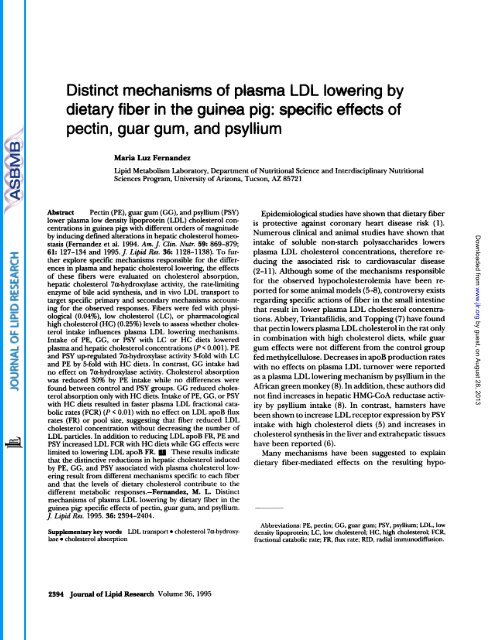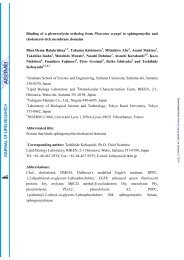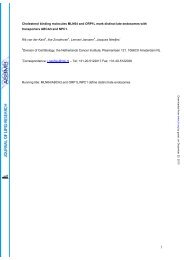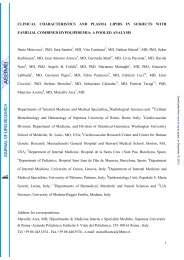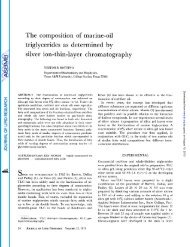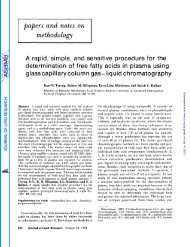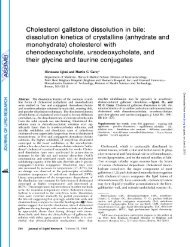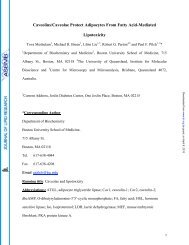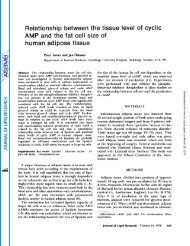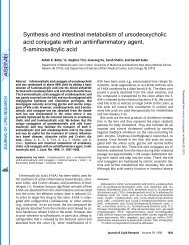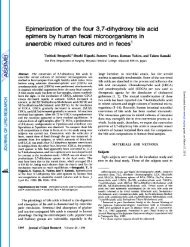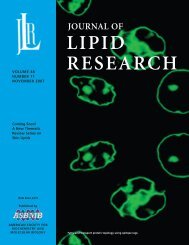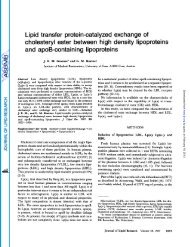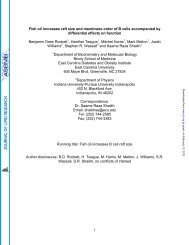a LDL lowering by - The Journal of Lipid Research
a LDL lowering by - The Journal of Lipid Research
a LDL lowering by - The Journal of Lipid Research
Create successful ePaper yourself
Turn your PDF publications into a flip-book with our unique Google optimized e-Paper software.
Distinct mecha<br />
dietary fiber in the g<br />
pectin, guar gu<br />
a <strong>LDL</strong> <strong>lowering</strong> <strong>by</strong><br />
effects <strong>of</strong><br />
Maria Luz Fernandez<br />
<strong>Lipid</strong> Metabolism Laboratory, Department <strong>of</strong> Nutritional Science and Interdisciplinary Nutritional<br />
Sciences Program, University <strong>of</strong> Arizona, Tucson, AZ 8572 1<br />
Abstract Pectin (PE), guar gum (CC), and psyllium (PSY)<br />
lower plasma low density lipoprotein (<strong>LDL</strong>) cholesterol concentrations<br />
in guinea pigs with different orders <strong>of</strong> magnitude<br />
<strong>by</strong> inducing defined alterations in hepatic cholesterol homeostasis<br />
(Fernandez et al. 1994. Am.J Clin. Nutr. 59: 869-879;<br />
61: 127-134 and 1995.J <strong>Lipid</strong> Res. 36 1128-1138). To further<br />
explore specific mechanisms responsible for the differences<br />
in plasma and hepatic cholesterol <strong>lowering</strong>, the effects<br />
<strong>of</strong> these fibers were evaluated on cholesterol absorption,<br />
hepatic cholesterol 7a-hydroxylase activity, the rate-limiting<br />
enzyme <strong>of</strong> bile acid synthesis, and in vivo <strong>LDL</strong> transport to<br />
target specific primary and secondary mechanisms accounting<br />
for the observed responses. Fibers were fed with physiological<br />
(0.04%), low cholesterol (LC), or pharmacological<br />
high cholesterol (HC)(0.25%) levels to assess whether cholesterol<br />
intake influences plasma <strong>LDL</strong> <strong>lowering</strong> mechanisms.<br />
Intake <strong>of</strong> PE, GG, or PSY with LC or HC diets lowered<br />
plasma and hepatic cholesterol concentrations (P < 0.001). PE<br />
and PSY upregulated 7a-hydroxylase activity %fold with LC<br />
and PE <strong>by</strong> 5-fold with HC diets. In contrast, CG intake had<br />
no effect on 7a-hydroxylase activity. Cholesterol absorption<br />
was reduced 30% <strong>by</strong> PE intake while no differences were<br />
found between control and PSY groups. CG reduced cholesterol<br />
absorption only with HC diets. Intake <strong>of</strong> PE, GG, or PSY<br />
with HC diets resulted in faster plasma <strong>LDL</strong> fractional catabolic<br />
rates (FCR) (P < 0.01) with no effect on <strong>LDL</strong> apoB flux<br />
rates (FR) or pool size, suggesting that fiber reduced <strong>LDL</strong><br />
cholesterol concentration without decreasing the number <strong>of</strong><br />
<strong>LDL</strong> particles. In addition to reducing <strong>LDL</strong> apoB FR, PE and<br />
PSY increased <strong>LDL</strong> FCR with HC diets while GG effects were<br />
limited to <strong>lowering</strong> <strong>LDL</strong> apoB FR. 1111 <strong>The</strong>se results indicate<br />
that the distinctive reductions in hepatic cholesterol induced<br />
<strong>by</strong> PE, GG, and PSY associated with plasma cholesterol <strong>lowering</strong><br />
result From different mechanisms specific to each fiber<br />
and that the levels <strong>of</strong> dietary cholesterol contribute to the<br />
different metabolic responses.-Fernandez, M. L. Distinct<br />
mechanisms <strong>of</strong> plasma <strong>LDL</strong> <strong>lowering</strong> <strong>by</strong> dietary fiber in the<br />
guinea pig: specific effects <strong>of</strong> pectin, guar gum, and psyllium.<br />
J. <strong>Lipid</strong> Res. 1995.36 2394-2404.<br />
Supplementary key words <strong>LDL</strong> transport cholesterol 7a-hydroxylase<br />
cholesterol absorption<br />
Epidemiological studies have shown that dietary fiber<br />
is protective against coronary heart disease risk (1).<br />
Numerous clinical and animal studies have shown that<br />
intake <strong>of</strong> soluble non-starch polysaccharides lowers<br />
plasma <strong>LDL</strong> cholesterol concentrations, therefore reducing<br />
the associated risk to cardiovascular disease<br />
(2-1 1). Although some <strong>of</strong> the mechanisms responsible<br />
for the observed hypocholesterolemia have been reported<br />
for some animal models (54, controversy exists<br />
regarding specific actions <strong>of</strong> fiber in the small intestine<br />
that result in lower plasma <strong>LDL</strong> cholesterol concentrations.<br />
Abbey, Triantafdidis, and Topping (7) have found<br />
that pectin lowers plasma <strong>LDL</strong> cholesterol in the rat only<br />
in combination with high cholesterol diets, while guar<br />
gum effects were not different from the control group<br />
fed methylcellulose. Decreases in apoB production rates<br />
with no effects on plasma <strong>LDL</strong> turnover were reported<br />
as a plasma <strong>LDL</strong> <strong>lowering</strong> mechanism <strong>by</strong> psyllium in the<br />
African green monkey (8). In addition, these authors did<br />
not find increases in hepatic HMGCoA reductase activity<br />
<strong>by</strong> psyllium intake (8). In contrast, hamsters have<br />
been shown to increase <strong>LDL</strong> receptor expression <strong>by</strong> PSY<br />
intake with high cholesterol diets (5) and increases in<br />
cholesterol synthesis in the liver and extrahepatic tissues<br />
have been reported (6).<br />
Many mechanisms have been suggested to explain<br />
dietary fiber-mediated effects on the resulting hypo-<br />
Abbreviations: PE, pectin; GG, guar gum; PSY, psyllium; <strong>LDL</strong>, low<br />
density lipoprotein; LC, low cholesterol; HC, high cholesterot; FCR,<br />
fractional catabolic rate; FR, flux rate; RID, radial immunodiffusion.<br />
Downloaded from www.jlr.org <strong>by</strong> guest, on August 28, 2013<br />
4394 <strong>Journal</strong> <strong>of</strong> <strong>Lipid</strong> <strong>Research</strong> Volume 36, 1995
cholesterolemia including decreases in cholesterol absorption<br />
(12), binding to bile acids (4), effects on hormones<br />
and other parameters (13), and production <strong>of</strong><br />
volatile fatty acids (14, 15), although controversy exists<br />
regarding this last mechanism (16). Based on the effects<br />
<strong>of</strong> soluble fiber on cholesterol and lipoprotein metabolism<br />
in guinea pigs (9-1 1) and other studies (5-7) <strong>of</strong> the<br />
proposed mechanisms, decreases in cholesterol absorption<br />
and interruption <strong>of</strong> bile acid enterohepatic circulation<br />
are the most likely candidates to explain plasma<br />
<strong>LDL</strong> <strong>lowering</strong>. In these studies (5-lo), soluble fiber has<br />
been shown to up-regulate hepatic HMG-CoA reductase<br />
activity (9-1 1) and increase cholesterol synthesis in hepatic<br />
and extrahepatic tissues (6), mechanisms not compatible<br />
with increased production <strong>of</strong> volatile fatty acids<br />
(16) which would result in decreased synthesis <strong>of</strong> cholesterol<br />
not increases in both liver and extra-hepatic<br />
tissues (6,9-11).<br />
Previous studies in guinea pigs have shown that the<br />
hypocholesterolemic effects <strong>of</strong> dietary fiber vary in the<br />
order <strong>of</strong> magnitude depending on the ability <strong>of</strong> the<br />
tested fiber to deplete hepatic cholesterol pools. This<br />
plasma cholesterol <strong>lowering</strong> has been associated to the<br />
type <strong>of</strong> fiber and the amount <strong>of</strong> dietary cholesterol<br />
present whether in physiological or pharmacological<br />
concentrations (9-1 1).<br />
<strong>The</strong>se studies propose that the plasma <strong>LDL</strong> <strong>lowering</strong><br />
is directly related to the depletion <strong>of</strong> hepatic cholesterol<br />
<strong>by</strong> dietary fiber, that the primary and secondary mechanisms<br />
accounting for the <strong>lowering</strong> <strong>of</strong> hepatic cholesterol<br />
concentrations vary depending on the type <strong>of</strong> fiber, and<br />
also that the amount <strong>of</strong> dietary cholesterol directly<br />
affects the metabolic responses. To test this hypothesis,<br />
guinea pigs were fed with one insoluble fiber (cellulose)<br />
(control diet) and three soluble fibers, pectin (PE), guar<br />
gum (GG), or psyllium (PSY), with two different levels<br />
<strong>of</strong> dietary cholesterol equivalent to an absorbed amount<br />
<strong>of</strong> 0.25- and 1.5times the endogenous cholesterol synthesis<br />
in guinea pigs (17) to evaluate effects <strong>of</strong> these<br />
fibers on cholesterol absorption, hepatic cholesterol<br />
7a-hydroxylase activity, and <strong>LDL</strong> transport as possible<br />
mechanisms associated with plasma <strong>LDL</strong> <strong>lowering</strong>.<br />
Guinea pigs were chosen in these and previous investigations<br />
based on similarities to humans in their observed<br />
response to dietary fiber (9-1 1,18), their lipoprotein<br />
pr<strong>of</strong>ile (9-1 l), the distribution <strong>of</strong> hepatic<br />
cholesterol pools (19), absence <strong>of</strong> forestomach which<br />
complicates studies in other animal models (20), and<br />
gender similarities in response to dietary fiber (21,22).<br />
Materials<br />
TABLE 1. Composition <strong>of</strong> test diets<br />
EXPERIMENTAL PROCEDURES<br />
Reagents were obtained from the following sources:<br />
[ 1,2,3H(N)]cholestero1 (1650.2 GBq/mmol), [4W]cholesterol<br />
(1.9GBq/mmol), Aquasol and Liquifluor were<br />
purchased from New England Nuclear (Boston, MA);<br />
cholesteryl oleate, glucose 6-phosphate, glucose 6-phosphate<br />
dehydrogenase, and NADP were from Sigma (St.<br />
Louis, MO); radioimmunodiffusion kits were from Bio-<br />
Rad (Hercules, CA); enzymatic cholesterol kits, cholesterol<br />
oxidase, cholesterol esterase, and hydroperoxidase<br />
were purchased from Boehringer Mannheim (Indian-<br />
Diet Composition<br />
Component Control' Pectin Guar Gum Psyllium<br />
Soy protein<br />
Palm oil<br />
Sucrose/corn starchb<br />
Mineral mixr<br />
Vitamin mi*<br />
Cholesterol"<br />
Cellulose<br />
Pectin<br />
Guar gum<br />
Psyllium<br />
22.4<br />
15.1<br />
39.6<br />
8.2<br />
1.1<br />
0.04<br />
12.5<br />
0<br />
0<br />
0<br />
22.4<br />
15.1<br />
39.6<br />
8.2<br />
1.1<br />
0.04<br />
0<br />
12.5<br />
0<br />
0<br />
wt %<br />
22.4<br />
15.1<br />
39.6<br />
8.2<br />
1.1<br />
0.04<br />
0<br />
0<br />
12.5<br />
0<br />
22.4<br />
15.1<br />
39.6<br />
8.2<br />
1.1<br />
0.04<br />
5.0<br />
0<br />
0<br />
7.5<br />
Control (12.5% cellulose).<br />
bSucrose-starch ratio 1.43.<br />
'Mineral and vitamin mix adjusted to meet NRC requirements for guinea pigs (14).<br />
"High cholesterol diets contain 0.25% cholesterol.<br />
Enew<br />
%<br />
23.0<br />
35.1<br />
41.9<br />
Downloaded from www.jlr.org <strong>by</strong> guest, on August 28, 2013<br />
Femnda Dietary fiber and mechanisms <strong>of</strong> plasma <strong>LDL</strong> <strong>lowering</strong> 2395
apolis, IN). High methoxylated pectin made from lime<br />
peels and containing 6.7% methoxyl groups and 74%<br />
galacturonic acid was obtained from Grinsted Products<br />
Inc. (Industrial Airport, KA); guar gum type MMM/12<br />
containing 8449% fiber, 10% protein, and 1.5% ash was<br />
provided <strong>by</strong> Meer Corporation (North Bergen, NJ);<br />
powdered psyllium husks +Y 40 -purified 95% and containing<br />
less than 3% fat and 1% protein were obtained<br />
from Meer Corporation (North Bergen, NJ).<br />
Diets<br />
Diets were prepared and pelleted <strong>by</strong> <strong>Research</strong> Diets,<br />
Inc. (New Brunswick, NJ). <strong>The</strong> eight diets had the same<br />
composition except for the fiber source and cholesterol<br />
content as indicated in Table 1. <strong>The</strong> fiber source was<br />
either 12.5% (w/w) cellulose (control diets), 12.5% pectin<br />
(PE), 12.5% guar gum (GG), or 7.5% (w/w) psyllium<br />
plus 5% (w/w) cellulose (PSY) (Table 1). Diets contained<br />
15% (w/w) palm oil (C16:O 43.3%, C18:O 4.1%, C18:l<br />
39.8%, C18:2 9.7%) and fat represented 35% <strong>of</strong> the<br />
energy content. <strong>The</strong> amount <strong>of</strong> cholesterol was either<br />
0.04% (w/w), low cholesterol (LC) or 0.25% (w/w), high<br />
cholesterol (HC) diets. <strong>The</strong>se dietary cholesterol concentrations<br />
were chosen to define the effects <strong>of</strong> fiber<br />
intake when the amount <strong>of</strong> absorbed dietary cholesterol<br />
is equivalent to 0.25 (0.04%) or to 1.5 (0.25%) times the<br />
TABLE 2. Plasma cholesterol and apoB concentrations <strong>of</strong> guinea<br />
pigs fed control, pectin, guar gum, and psyllium diets with low<br />
cholesterol (0.0496, w/w) or high cholesterol (0.25%, w/w)<br />
Diets Plasma Cholesterol ApoB<br />
Low cholesterol<br />
mgldl<br />
Control 68 f 12” 44.9 f 15.3<br />
Pectin 56 f 17b 46.2 f 9.8<br />
Guar gum 53 f 15’ 29.8 f 7.8<br />
Psyllium 46 f lob 45.1 f 12.2<br />
High cholesterol<br />
Control 167 f 38= 134.9 f 39.W<br />
Pectin 85 f 2gb 83.6 f 34.2b<br />
Guar gum 104 f 38b 95.8 f 22.6b<br />
Psyllium 75 f 25’ 70.1 f 5.4’<br />
Two-way ANOVA<br />
Fiber effect P < 0.0001 P = 0.03<br />
Cholesterol effect P < 0.0001 P < 0.0001<br />
Interaction N.S. N.S.<br />
Values are presented as mean f SD for n = 21 animals per dietary<br />
group for plasma cholesterol and n = 6-8 for apoB concentrations.<br />
Values in the same column within the low or high cholesterol group<br />
with different superscripts are significantly different as determined <strong>by</strong><br />
one-way ANOVA and Newman-Keules post hoc test (E‘ < 0.001).<br />
daily endogenous cholesterol synthesis rate in guinea<br />
pigs (17).<br />
Animals<br />
Male guinea pigs weighing 250-300 g were randomly<br />
assigned to one <strong>of</strong> eight dietary groups for 4 weeks. <strong>The</strong>y<br />
were housed in a light cycle room (light 7 AM to 7 PM)<br />
and had access to diets and water ad libitum. No differences<br />
in weight gain/day were observed for animals fed<br />
the different diets in agreement with previous reports<br />
(9-1 1). Animals used for the in vitro experiments were<br />
killed <strong>by</strong> heart puncture after halothane anesthesia and<br />
plasma and livers were harvested. Animals used for the<br />
in vivo studies were killed <strong>by</strong> an excess <strong>of</strong> halothane<br />
vapors. All animal experiments were conducted in accordance<br />
with U.S. Public Health Service/U.S. Department<br />
<strong>of</strong> Agriculture guidelines, and experimental protocols<br />
were approved <strong>by</strong> the University <strong>of</strong> Arizona<br />
Institutional Animal Care and Use Committee.<br />
Plasma <strong>LDL</strong> isolation and labeling<br />
Plasma cholesterol concentrations were determined<br />
<strong>by</strong> enzymatic analysis (23). Pooled <strong>LDL</strong> from each dietary<br />
group were separated <strong>by</strong> sequential ultracentrifugation<br />
in a L&M ultracentrifuge (Beckman Instruments,<br />
Palo Alto, CA) at 125,000 g at 15°C for 19 h in a Ti-50<br />
rotor at a density range <strong>of</strong> 1.02 to 1.09 g/ml and dialyzed<br />
against 0.09% NaCl and 0.01% EDTA for 24 h. Purity <strong>of</strong><br />
the <strong>LDL</strong> preparations was checked <strong>by</strong> SDS-PAGE and<br />
only apoB was detected (data not shown).<br />
Human <strong>LDL</strong> was isolated <strong>by</strong> sequential ultracentrifugation<br />
between densities 1.019 to 1.063 g/ml and<br />
washed at 1.063 g/ml. Methylated human <strong>LDL</strong> was<br />
prepared as described <strong>by</strong> Weisgraber, Innerarity, and<br />
Mahley (24) and the specificity <strong>of</strong> the methylation procedure<br />
was confirmed as previously described (25). Iodination<br />
<strong>of</strong> guinea pig <strong>LDL</strong> (pooled <strong>LDL</strong> from three<br />
animals fed the homologous diet) and human methylated<br />
<strong>LDL</strong> was performed according to the method <strong>of</strong><br />
Goldstein, Basu, and Brown (26). <strong>The</strong> same batch <strong>of</strong><br />
guinea pig <strong>LDL</strong> was used for all animals fed the same<br />
diet and the radiolabeled <strong>LDL</strong> were used within 2-3 days<br />
<strong>of</strong> preparation to minimize potential changes during<br />
oxidation (27).<br />
Determination <strong>of</strong> apoB concentrations<br />
Polyclonal antibodies against apoB-100 were prepared<br />
<strong>by</strong> injecting guinea pig purified <strong>LDL</strong> (checked <strong>by</strong><br />
SDS-PAGE) into a sheep in one dose (300 pg/ml) followed<br />
<strong>by</strong> two booster doses (200 kg/ml) every 10 days.<br />
Antibodies were purified <strong>by</strong> use <strong>of</strong> antigen affinity column<br />
and apoB antibodies were eluted <strong>by</strong> modification<br />
<strong>of</strong> pH (28). <strong>The</strong> specificity <strong>of</strong> the polyclonal antibodies<br />
was tested <strong>by</strong> use <strong>of</strong> RID kits. ApoB concentrations in<br />
Downloaded from www.jlr.org <strong>by</strong> guest, on August 28, 2013<br />
9396 Joud <strong>of</strong> <strong>Lipid</strong> <strong>Research</strong> Volume 36,1995
TABLE 3. Hepatic cholesterol concenuationsandcholesterol7a-hydroxyiaseactivity<strong>of</strong>guineapigsfedcontrol,<br />
pectin, guar gum, and psylliumdietswith low cholesterol (0.04%, w/w) orhighcholesterol( 0.2596, w/w)<br />
Hepatic Cholesterol<br />
Diets Free Esterified Cholesterol 7a-Hydroxylase<br />
Low cholesterol<br />
wg<br />
pmol/min-mg<br />
Control 3.10 f 0.31O 0.31 f 0.02' 1.19 f 0.17b<br />
Pectin 2.52 f 0.226 0.21 f 0.076 3.27 f 0.69<br />
Guar gum 2.43 f 0.1W 0.26 f 0.Olb 1.12 f 0.6W<br />
Psyllium 2.51 f O.llb 0.13 f 0.04b 3.06 f 0.7W<br />
High cholesterol<br />
Control<br />
Pectin<br />
Guar gum<br />
Psyllium<br />
5.42 f 1.12' 2.81 f 0.5P 1.54 f 0.2P<br />
2.22 f 0.23 0.15 f 0.07c 5.07 f 2.3W<br />
4.03 f 0.79 2.10 f 1.546<br />
1.30 f 0.08'<br />
3.32 f O.3lb 0.93 f 0.51' 2.51 f 0.62*<br />
Two-way ANOVA<br />
Fiber effect<br />
Cholesterol effect<br />
Interaction<br />
P < 0.001<br />
P < 0.001<br />
N.S.<br />
P = 0.01<br />
P < 0.001<br />
P = 0.02<br />
P = 0.05<br />
N.S.<br />
N.S.<br />
Values are presented as mean f SD for n = 6 animals per dietary group. Values in the same column within<br />
the low or high cholesterol groups with different superscripts are significantly different as determined <strong>by</strong> one-way<br />
ANOVA and Newman-Keules post hoc test (P < 0.001).<br />
plasma and <strong>LDL</strong> samples were measured <strong>by</strong> silver-enhanced<br />
radioimmunodiffusion (SERID) in which the<br />
antigen was allowed to diffuse radially from wells<br />
punched into gel media containing the antibody (29).<br />
RID plates were incubated at 37°C for 24-72 h. Nonspecific<br />
proteins were removed <strong>by</strong> applying pressure for 1<br />
h and the gels were dyed with Coomassie blue. Diameters<br />
<strong>of</strong> the immunoprecipitate were read using an RID<br />
reader. Linear regression equations were generated for<br />
the standard calibrator curve to calculate sample concentrations.<br />
<strong>The</strong> standards were prepared <strong>by</strong> isolating<br />
guinea pig <strong>LDL</strong> at a more restricted density (d =<br />
1.023-1.075 g/ml) and further purification <strong>by</strong> use <strong>of</strong><br />
agarose column chromatography. <strong>The</strong> purity <strong>of</strong> <strong>LDL</strong><br />
was checked <strong>by</strong> SDS-PAGE. Protein was determined <strong>by</strong><br />
a modification <strong>of</strong> the Lowry method (30) and standards<br />
ranging in concentration from 0 to 650 pg/ml were<br />
prepared.<br />
Hepatic cholesterol concentrations and cholesterol<br />
7a-hydroxylase assay<br />
Hepatic concentrations <strong>of</strong> total and free cholesterol<br />
were determined according to Carr, Andresen, and<br />
Rude1 (31) and esterified cholesterol was calculated as<br />
the difference between free and total cholesterol. Cholesterol<br />
7a-hydroxylase (EC 1.14.13.7) activity was as-<br />
sayed essentially as described <strong>by</strong> Jelinek et al. (32) using<br />
['4C]cholesterol as substrate except that cholesterol was<br />
delivered as cholesterol-phosphatidylcholine liposomes<br />
(123 <strong>by</strong> weight) prepared <strong>by</strong> sonication; an NADPH-regenerating<br />
system (glucose-6-phosphate dehydrogenase,<br />
NADP, and glucose &phosphate) was included<br />
in the assay as a source <strong>of</strong> NADPH. After addition <strong>of</strong><br />
glucose-&phosphate dehydrogenase (0.3 I.U.), samples<br />
were incubated for an additional 30 min. <strong>The</strong> reaction<br />
was stopped <strong>by</strong> addition <strong>of</strong> 5 ml <strong>of</strong> chlor<strong>of</strong>orm-methano1<br />
3:l and 1 ml <strong>of</strong> acidified waster (5% sulfuric acid).<br />
Tubes were mixed, the top layer was discarded, and<br />
samples were dried under nitrogen. Samples and 7aand<br />
7j3-hydroxycholesterol standards each were dissolved<br />
in 100 pl chlor<strong>of</strong>orm, applied to silica gel TLC<br />
plates and developed with ethyl acetatedoluene 3:2. <strong>The</strong><br />
plate was placed on XAR-5 film with intensifying screen<br />
overnight and placed in iodine vapors to mark the 7a<br />
and 7p standards. Using the film as a guide, the locations<br />
<strong>of</strong> the [ 14C]7a-hydroxycholesterol spots were determined,<br />
scraped from the plate, and counted in a liquid<br />
scintillation counter.<br />
Metabolic studies<br />
Plasma <strong>LDL</strong> turnover kinetics were determined as<br />
previously described (25). FCR values were calculated<br />
Downloaded from www.jlr.org <strong>by</strong> guest, on August 28, 2013<br />
Fmandetl Dietarv fiber and mechpLljsms <strong>of</strong> D I " ~ <strong>LDL</strong> lowerinn !Z397
TABLE 4. Cholesterol absorption <strong>of</strong> guinea pigs fed control, pectin, guar gum, and psyllium diets with low<br />
cholesterol (0.04%, w/w) or high cholesterol (0.2546, w/w)<br />
Cholesterol Absorption<br />
Diets Control Pectin Guar Gum Psyllium<br />
Low cholesterol<br />
High cholesterol<br />
Two-way Anova<br />
Fiber effect<br />
Cholesterol effect<br />
Interaction<br />
%<br />
60.8 f 19.5* 37.1 f 5.3b 64.2 f 12.4O 64.6 f 1O.P<br />
64.1 f 10.3n 47.3 f 12.7b 44.5 f 14.4b 61.8 f 15.&<br />
N.S.<br />
N.S.<br />
N.S.<br />
Values are presented as mean f SD for n = 6 animals per dietary group, except for pectin where n = 5.<br />
Values in the same row with different superscripts are significantly different as determined <strong>by</strong> ANOVA and<br />
Newman-Keules post hoc test (P < 0.001).<br />
using a two pool model as described <strong>by</strong> Mathews (33).<br />
For all studies, guinea pig <strong>LDL</strong> kinetics were measured<br />
over a period <strong>of</strong> 28 h <strong>by</strong> sampling plasma <strong>LDL</strong> radioactivity<br />
at 5 min (zero time), and at 0.5, 1, 2.5, 5, 10, 20,<br />
24, and 28 h after injection <strong>of</strong> the radiolabeled <strong>LDL</strong>.<br />
Samples were obtained <strong>by</strong> taking 300-pl blood samples<br />
via an indwelling catheter <strong>of</strong> silastic tubing, I.D. 0.64 mm<br />
(Dow Corning, Corning NY) inserted into the femoral<br />
artery. 1*51-labeled <strong>LDL</strong> (70 pg protein) from guinea pigs<br />
fed the homologous diet and 1311-labeled methylated<br />
human <strong>LDL</strong> (40 pg protein) were simultaneously injected<br />
into guinea pigs to determine total and receptorindependent<br />
FCR, respectively (25). Receptor-mediated<br />
clearance was calculated <strong>by</strong> subtracting non-receptor<br />
<strong>LDL</strong> FCR from total FCR. <strong>LDL</strong> apoB pool size was<br />
calculated <strong>by</strong> multiplying the mg/ml obtained <strong>by</strong> radioimmunodiffusion<br />
x plasma volume (ml/kg) = mg/kg<br />
with the assumption <strong>of</strong> 45 ml plasma/kg in guinea pigs,<br />
and <strong>LDL</strong> apoB flux rates were calculated <strong>by</strong> multiplying<br />
the pool size x FCR.<br />
Cholesterol absorption<br />
Cholesterol absorption was determined <strong>by</strong> the<br />
method <strong>of</strong> Zilversmit (34) which has been validated in<br />
guinea pigs (35). Food was withdrawn from animals 12<br />
h before they were given 370 GBq <strong>of</strong> [1,23H(N)]cholesterol<br />
orally <strong>by</strong> adding 10 pl <strong>of</strong> the radiolabeled isotope<br />
to one pellet <strong>of</strong> the corresponding diet. <strong>The</strong> [3H]cholesterol<br />
was promptly adsorbed <strong>by</strong> the pellet and guinea<br />
pigs consumed it within 2 min, followed <strong>by</strong> appropriate<br />
amounts <strong>of</strong> water and food. Once the pellet was consumed,<br />
animals were injected with 5.63 GBq <strong>of</strong> [4-<br />
14C]cholesterol through an indwelling catheter inserted<br />
in the femoral artery. <strong>The</strong> [14C]cholesterol was mixed<br />
with guinea pig plasma, incubated for 15 min at 37"C,<br />
and vortexed for 10 min prior to injection. Blood samples<br />
(300 p1) were taken every 12 h up to 72 h to ensure<br />
that the plasma isotope ratio had reached equilibrium<br />
(35). Plasma was separated from red blood cells, mixed<br />
with Aquasol, and counted. Cholesterol absorption was<br />
calculated from the ratio <strong>of</strong> 14C (injected dose) to 3H<br />
(oral dose) multiplied <strong>by</strong> the ratio <strong>of</strong> 9H to 14C in plasma<br />
at the time <strong>of</strong> equilibrium.<br />
Statistical analysis<br />
One-way ANOVA and the Newman-Keules post hoc<br />
test (GBSTAT, Silver Spring, MD) were used to determine<br />
differences between dietary treatments in plasma<br />
and hepatic cholesterol concentrations, cholesterol absorption,<br />
activity <strong>of</strong> cholesterol 7cr-hydroxylase, and<br />
<strong>LDL</strong> kinetics variables within the low and high choles<br />
terol groups. Two-way ANOVA was used to determine<br />
fiber effects, cholesterol effects, and interactions. Values<br />
were considered significant with P < 0.05. Significant<br />
correlations were calculated <strong>by</strong> use <strong>of</strong> linear regression.<br />
RESULTS<br />
Plasma cholesterol concentrations were significantly<br />
decreased <strong>by</strong> dietary fiber in both the LC and the HC<br />
groups (Table 2). PE, GG, and PSY lowered plasma<br />
cholesterol <strong>by</strong> 18,21, and 32% in the LC group and 50,<br />
38, and 55% in the HC groups, respectively. Two-way<br />
ANOVA indicated a fiber effect in reducing plasma<br />
cholesterol concentrations and a cholesterol effect in<br />
increasing plasma cholesterol levels with higher levels <strong>of</strong><br />
dietary cholesterol (Table 2). No effect <strong>of</strong> fiber on<br />
Downloaded from www.jlr.org <strong>by</strong> guest, on August 28, 2013<br />
2598 <strong>Journal</strong> <strong>of</strong> <strong>Lipid</strong> <strong>Research</strong> Volume 36,1995
TABLE 5. <strong>LDL</strong> kinetic parameters <strong>of</strong> guinea pigs fed control, pectin, guar gum, and psyllium diets with low<br />
cholesterol (0.04%. w/w) or high cholesterol (0.25%. w/w)<br />
Diets ApoB Pool Size FCR ApoB Production tes<br />
Low cholesterol<br />
Control<br />
Pectin<br />
Guar gum<br />
Psyllium<br />
19.2 f 5.8 0.073 f 0.005b 1.42 f 0.36<br />
19.7 f 4.2 0.093 f 0.0059 1.70 f 0.53<br />
12.7 It 3.4 0.113 f 0.020. 1.58 f 0.30<br />
19.0 f 5.2 0.103 f 0.0150 1.95 f 0.62<br />
High cholesterol<br />
Control<br />
Pectin<br />
Guar gum<br />
Psyllium<br />
51.8 f 13.e 0.057 f 0.0096 2.81 f 0.50.<br />
32.3 f 13.66 0.078 f 0.0190 2.17 f 0.496<br />
37.3 f 8.7b 0.059 f 0.0166 2.10 It 0.39<br />
26.5 f 2.V 0.080 f 0.010. 2.08 f 0.406<br />
Twmway ANOVA<br />
Fiber effect P = 0.033 P < 0.0001 P = 0.003<br />
Cholesterol effect P < 0.0001 P < 0.0001 P = 0.004<br />
Interaction N.S. N.S. P = 0.01<br />
Values are presented as mean f SD for n - 5-8 animals per dietary group. Values in the same column within<br />
the low or high cholesterol groups with different superscripts are significantly different as determined <strong>by</strong> one-way<br />
ANOVA and the Newman-Keules post hoc test (P < 0.001).<br />
plasma apoB levels was observed for animals fed the<br />
physiological levels <strong>of</strong> dietary cholesterol (LC diets)<br />
while PE, GG, and PSY significantly reduced plasma<br />
apoB concentrations in the HC group, indicating that<br />
fiber reduced not only the amount <strong>of</strong> total cholesterol<br />
but, in addition, the number <strong>of</strong> lipoprotein particles<br />
(Table 2). A fiber effect in reducing plasma apoB concentrations<br />
was detected <strong>by</strong> two-way ANOVA while<br />
increasing the amount <strong>of</strong> dietary cholesterol resulted in<br />
increases in plasma apoB levels, suggesting a higher<br />
number <strong>of</strong> apoB-containing lipoproteins.<br />
Hepatic cholesterol concentrations in both the free<br />
and esterified pools were reduced <strong>by</strong> dietary soluble<br />
fiber (Table 3). For animals fed LC diets, free cholesterol<br />
was reduced an average <strong>of</strong> 20% <strong>by</strong> intake <strong>of</strong> the three<br />
fiber sources while PSY had the most pronounced effect<br />
in <strong>lowering</strong> hepatic esterified cholesterol, followed <strong>by</strong><br />
PE and GG (Table 3).<br />
<strong>The</strong> <strong>lowering</strong> <strong>of</strong> hepatic cholesterol in animals fed HC<br />
diets differed in order <strong>of</strong> magnitude depending on the<br />
fiber source. PE had the most pronounced cholesterol<strong>lowering</strong><br />
effect as it reduced <strong>by</strong> 60 and 95% the free and<br />
esterified hepatic cholesterol pools, respectively; PSY<br />
had an intermediate effect while GG effects were moderate<br />
(Table 3). <strong>The</strong>se differences in hepatic cholesterol<strong>lowering</strong><br />
result from different mechanisms as will be<br />
demonstrated in subsequent experiments. Hepatic cho-<br />
lesterol 7a-hydroxylase was upregulated 3-fold <strong>by</strong> PE<br />
and PSY in animals fed LC diets. PE upregulated the<br />
enzyme activity <strong>by</strong> 5-fold in animals fed HC diets while<br />
the effects <strong>of</strong> PSY on cholesterol 7a-hydroxylase were<br />
more modest. In contrast to PE and PSY, GG intake did<br />
not affect hepatic cholesterol 7a-hydroxylase activity in<br />
either the LC or HC groups (Table 3).<br />
To determine whether the reduction in hepatic cholesterol<br />
concentrations was due to decreased delivery <strong>of</strong><br />
cholesterol to the liver <strong>by</strong> chylomicron remnants, the<br />
effects <strong>of</strong> fiber on cholesterol absorption were measured.<br />
PE reduced cholesterol absorption <strong>by</strong> 40 and 26%<br />
in animals fed both the LC and HC diets, respectively<br />
(Table 4). GG decreased cholesterol absorption <strong>by</strong> 28%<br />
only in animals fed HC diets. PSY did not affect cholesterol<br />
absorption compared to animals fed control diets<br />
in the presence <strong>of</strong> either low or high concentrations <strong>of</strong><br />
dietary cholesterol (Table 4).<br />
<strong>LDL</strong> metabolic parameters were distinctively affected<br />
<strong>by</strong> dietary fiber type. <strong>LDL</strong> fractional catabolic rates<br />
(FCR) were increased <strong>by</strong> PE, GG, and PSY in animals<br />
fed LC diets while there was no effect on <strong>LDL</strong> apoB flux<br />
rates or <strong>LDL</strong> apoB pool size (Table 5). As dietary soluble<br />
fiber reduced plasma cholesterol concentrations and<br />
guinea pigs carry the majority <strong>of</strong> cholesterol in <strong>LDL</strong>,<br />
these data indicate that the number <strong>of</strong> <strong>LDL</strong> particles was<br />
not affected <strong>by</strong> fiber but the size <strong>of</strong> the <strong>LDL</strong> was,<br />
Downloaded from www.jlr.org <strong>by</strong> guest, on August 28, 2013<br />
Dietary fiber and mechanisms <strong>of</strong> plasma <strong>LDL</strong> <strong>lowering</strong> 2399
esulting in smaller particles containing less cholesterol<br />
per particle as was observed previously (9-1 1).<br />
In animals fed the HC diets, the mechanisms <strong>of</strong><br />
plasma <strong>LDL</strong> <strong>lowering</strong> were different and dependent on<br />
the type <strong>of</strong> fiber. Dietary PE and PSY increased <strong>LDL</strong><br />
FCR while GG did not affect plasma <strong>LDL</strong> turnover.<br />
However, a reduction <strong>of</strong> <strong>LDL</strong> apoB flux rates was observed<br />
in animals fed GG, PE, and PSY (Table 5).<br />
Two-way ANOVA indicated a fiber effect in increasing<br />
FCR and decreasing apoB flux rates although this last<br />
parameter was mostly affected <strong>by</strong> results from the HC<br />
group (Table 5). Dietary cholesterol significantly increased<br />
<strong>LDL</strong> apoB pool size, decreased <strong>LDL</strong> FCR, and<br />
increased <strong>LDL</strong> apoB flux rates as indicated <strong>by</strong> two-way<br />
ANOVA.<br />
<strong>The</strong>re was a significant positive correlation between<br />
plasma cholesterol concentrations and <strong>LDL</strong> FCR for<br />
animals from all dietary groups (Fig. 1) indicating that<br />
plasma <strong>LDL</strong> turnover rates are strong determinants <strong>of</strong><br />
plasma cholesterol concentrations. <strong>The</strong> slower FCR observed<br />
in animals fed HC diets compared to the LC<br />
group are illustrated in Fig. 2 for animals from the PSY<br />
group. Similar curves were obtained for the PE, GG, and<br />
control groups (data not shown). Receptor-mediated<br />
<strong>LDL</strong> FCR was faster in animals fed PE, GG, and PSY<br />
with LC and HC diets than in control animals (Fig. 3).<br />
In addition, animals fed LC diets exhibited faster nonreceptor-mediated<br />
clearance than animals fed HC diets<br />
which made a significant contribution to total <strong>LDL</strong> FCR<br />
(Fig. 3).<br />
<strong>The</strong>re was a significant positive correlation between<br />
plasma cholesterol levels and hepatic cholesterol concentrations<br />
in all dietary groups (Fig. 4) associated with<br />
the <strong>lowering</strong> <strong>of</strong> hepatic cholesterol pools resulting from<br />
dietary fiber effects on primary and secondary mecha-<br />
E<br />
Ti Y<br />
a<br />
u<br />
0.20<br />
r = -0.77<br />
0.15-1 8 P
0.16<br />
0.12<br />
0.08<br />
0.04<br />
0.00<br />
0.16<br />
0.1 2<br />
0.08<br />
0.04<br />
0.00<br />
I<br />
LOW CHOLESTEROL<br />
HIGH CHOLESTEROL<br />
CNT PE GG PSY<br />
Fig. 3. Receptor-dependent (open bar) and receptorindependent<br />
(hatched bar) <strong>LDL</strong> turnover rates <strong>of</strong> guinea pigs fed control (CNT),<br />
pectin (PE), guar gum (CC), and psyllium (PSY) diets with low<br />
cholesterol (0.04%)(upper panel) and high cholesterol (0.25%)(lower<br />
panel). Each bar represents the mean f SD <strong>of</strong> 5-8 animals; *represents<br />
significantly different from the control diet. Two-way ANOVA indicated<br />
that receptor-independent FCR was significantly higher in animals<br />
fed the low cholesterol diets (P < 0.05).<br />
balance as this organ is responsible for the absorption<br />
<strong>of</strong> dietary and biliary cholesterol and for the reabsorption<br />
<strong>of</strong> bile acids. Further, as the absorption <strong>of</strong> cholesterol<br />
through the small intestine is a linear function <strong>of</strong><br />
its concentration in the lumen (39), it is expected that<br />
animals fed HC diets will have increased delivery <strong>of</strong><br />
cholesterol to the liver through chylomicron remnants<br />
as is the case in the control guinea pigs. <strong>The</strong>refore, it is<br />
not surprising that the effects <strong>of</strong> fiber in the gastrointestinal<br />
tract will be influenced <strong>by</strong> the amount <strong>of</strong> dietary<br />
cholesterol.<br />
<strong>The</strong> present studies demonstrated that the significant<br />
depletion <strong>of</strong> hepatic cholesterol pools induced <strong>by</strong> nonstarch<br />
polysaccharides was due to decreases in cholesterol<br />
absorption and alterations in the enterohepatic<br />
circulation <strong>of</strong> bile acids as manifested <strong>by</strong> the up-regulation<br />
<strong>of</strong> hepatic cholesterol 7a-hydroxylase, the regulatory<br />
enzyme <strong>of</strong> bile acid synthesis. <strong>The</strong> fiber sources<br />
evaluated in these studies had different actions possibly<br />
associated with their chemical structures and their physicochemical<br />
properties. Similar to the present results, PE<br />
although <strong>of</strong> low viscosity has been found to reduce<br />
cholesterol absorption in animal and human studies (40,<br />
41). This capacity <strong>of</strong> pectin to reduce cholesterol absorption<br />
and its possible interruption <strong>of</strong> the enterohepatic<br />
circulation <strong>of</strong> bile acids, as suggested in the present<br />
investigation <strong>by</strong> the up-regulation <strong>of</strong> cholesterol 7a-h~droxylase,<br />
resulted in a significant reduction 4f hepatic<br />
free and esterified cholesterol pools especially in guinea<br />
pigs fed the PE-HC diet compared to animals fed HC<br />
with GG or PSY. PSY effects in <strong>lowering</strong> hepatic cholesterol<br />
were mostly due to interruption <strong>of</strong> enterohepatic<br />
circulation <strong>of</strong> bile acids as suggested <strong>by</strong> the observed<br />
increases in 7a-hydroxylase activity as no effects on<br />
cholesterol absorption were observed in agreement with<br />
clinical and animal studies (2, 42). <strong>The</strong> effects <strong>of</strong> GG in<br />
the small intestine are harder to interpret although a<br />
decrease in cholesterol absorption was observed in animals<br />
fed GG with high cholesterol diets. However, no<br />
effects <strong>of</strong> GG in cholesterol 7a-hydroxylase activity were<br />
detected although studies in the rat (14) and in humans<br />
(4) do suggest that GG increases bile acid excretion. <strong>The</strong><br />
primary mechanisms involved in reducing hepatic cholesterol<br />
concentrations are strongly correlated with the<br />
resulting cholesterol-<strong>lowering</strong> effects and it would appear<br />
from these results that bile acid excretion has a<br />
more potent effect in determining hepatic cholesterol<br />
concentrations in animals fed HC diets, as the lowest<br />
concentrations <strong>of</strong> hepatic cholesterol were observed in<br />
the PE group that had the highest enzyme activity while<br />
GG had the highest hepatic cholesterol concentrations<br />
and cholesterol 7a-hydroxylase activity was not different<br />
from the control. For animals fed GG-LC, the primary<br />
mechanisms <strong>of</strong> hepatic cholesterol-<strong>lowering</strong> were not<br />
evident in the present study as no effects <strong>of</strong> GG on<br />
cholesterol absorption or increased activity <strong>of</strong> cholesterol<br />
7a-hydroxylase were detected. It is possible that a<br />
combination <strong>of</strong> multiple mechanisms including the ones<br />
evaluated in this experiment could have taken place but<br />
were not identified under the present experimental<br />
conditions.<br />
Fiber effects on hepatic cholesterol metabolism and<br />
plasma cholesterol levels<br />
It is well known that the liver plays a major role in the<br />
levels <strong>of</strong> circulating <strong>LDL</strong> through the regulation <strong>of</strong><br />
V<strong>LDL</strong> synthesis and <strong>LDL</strong> catabolism <strong>by</strong> the apoB/E<br />
receptor (43). <strong>The</strong> decreases in hepatic cholesterol concentrations,<br />
specifically in the free pool, induced <strong>by</strong> PE,<br />
GG, and PSY in animals fed the LC diets resulted in an<br />
up-regulation <strong>of</strong> <strong>LDL</strong> receptors as indicated <strong>by</strong> the faster<br />
plasma total and receptor-mediated <strong>LDL</strong> turnover;<br />
these observations are in agreement with prex 'ious '<br />
reports<br />
<strong>of</strong> increased <strong>LDL</strong> binding to hepatic membranes<br />
(9-12). Animals fed the LC diets independent <strong>of</strong> the<br />
non-starch polysaccharide source had a higher contribu-<br />
Downloaded from www.jlr.org <strong>by</strong> guest, on August 28, 2013<br />
FrmandPz Dietary fiber and mechanisms <strong>of</strong> plasma <strong>LDL</strong> <strong>lowering</strong> 2401
U<br />
150 ]<br />
T P<br />
0' I I<br />
P 0.05<br />
1 3 5 7<br />
HEPATIC FREE CHOLESTEROL<br />
~mg/g)<br />
Fig. 4. Correlation between plasma cholesterol levels (n = 21) and<br />
hepatic free cholesterol concentrations (n = 6) <strong>of</strong> guinea pigs fed<br />
control (0, O), pectin (A, A), guar gum (0, e), or psyllium (0, B).<br />
Open symbols represent low cholesterol (0.04%. w/w) and dark<br />
symbols high cholesterol (0.25%, w/w) groups.<br />
tion <strong>of</strong> the non-receptor-mediated pathway than animals<br />
fed the HC diets, suggesting that dietary cholesterol<br />
possibly affected the packing <strong>of</strong> the membrane lipid<br />
bilayer decreasing non-receptor pathways via endocytosis<br />
(44). As no effects were observed in <strong>LDL</strong> apoB pool<br />
size, the results suggest the presence <strong>of</strong> smaller <strong>LDL</strong><br />
particles containing less cholesterol. Previous studies in<br />
guinea pigs have shown that smaller <strong>LDL</strong> particles induced<br />
<strong>by</strong> polyunsaturated fat intake have faster plasma<br />
<strong>LDL</strong> FCR (45,46) suggesting that the cholesteryl esterdepleted<br />
<strong>LDL</strong>s generated <strong>by</strong> fiber might have contributed<br />
to the faster plasma <strong>LDL</strong> turnover.<br />
In animals fed the HC diets, PE and PSY not only<br />
increased <strong>LDL</strong> FCR, but decreases in <strong>LDL</strong> apoB flux<br />
rates were observed <strong>by</strong> intake <strong>of</strong> the three fiber sources,<br />
which suggests either decreased synthesis <strong>of</strong> V<strong>LDL</strong> or a<br />
decreased conversion <strong>of</strong> V<strong>LDL</strong> to <strong>LDL</strong>. Similar to these<br />
results, Turley and Dietschy (47) reported that the hypocholesterolemic<br />
effect <strong>of</strong> PSY in hamsters were related<br />
to decreases in <strong>LDL</strong> production and increases in<br />
<strong>LDL</strong> receptor-mediated activity although they found<br />
that the first mechanism was more important. Nascent<br />
V<strong>LDL</strong> from cholesterol-fed guinea pigs has been shown<br />
to have a high concentration <strong>of</strong> cholesteryl ester derived<br />
from hepatic pools (48). In addition, previous studies in<br />
guinea pigs have shown that animals fed high cholesterol<br />
diets exhibit a circulating V<strong>LDL</strong> that contains more<br />
cholesteryl ester and free cholesterol than V<strong>LDL</strong> isolated<br />
from animals fed LC (11). Further, PSY intake<br />
reversed the composition <strong>of</strong> this cholesteryl ester-enriched<br />
V<strong>LDL</strong> making it similar to V<strong>LDL</strong> from the LC<br />
group (11). As PSY also reduced the concentration <strong>of</strong><br />
plasma <strong>LDL</strong> cholesterol, one can speculate that the<br />
cholesteryl ester-depleted V<strong>LDL</strong> induced <strong>by</strong> PSY intake<br />
is not readily converted to <strong>LDL</strong> through the delipidation<br />
cascade, and the decreases in <strong>LDL</strong> apoB flux rates in<br />
animals fed PSY, PE, and GG with HC observed in the<br />
present study reinforce this hypothesis. However, as<br />
high cholesterol diets have been shown to up-regulate<br />
cholesteryl ester transfer protein (CETP) activity (49),<br />
and lipoprotein lipase (LPL) has a major role in the<br />
conversion <strong>of</strong> V<strong>LDL</strong> to <strong>LDL</strong> (50), a contribution <strong>of</strong><br />
soluble fiber in decreasing CETP activity in the intravascular<br />
compartment or in affecting LPL activity cannot<br />
be overruled. As LPL and apoB/E receptor are regulated<br />
<strong>by</strong> insulin/glucagon ratios (5 1,52), it could be that<br />
dietary fiber also contributes to plasma <strong>LDL</strong> <strong>lowering</strong><br />
<strong>by</strong> affecting hormone metabolism as has been postulated<br />
(13), a possibility that should be explored further.<br />
Another point to consider is that although a strong<br />
correlation was found between hepatic cholesterol concentrations<br />
and plasma cholesterol levels, individual<br />
fiber sources did not have similar plasma and hepatic<br />
cholesterol-<strong>lowering</strong> effects, suggesting that fiber may<br />
also influence transport proteins and enzymes in the<br />
intravascular compartment that contribute to plasma<br />
lipoprotein levels. In addition, results from the GG-LC<br />
group suggest that there must be other primary mechanisms<br />
affecting hepatic cholesterol concentrations as<br />
animals fed GG with LC diets exhibited similar cholesterol-<strong>lowering</strong><br />
effects to PE or PSY and no changes in<br />
cholesterol absorption or inductions <strong>of</strong> 7ct-hydroxylase<br />
activity were detected.<br />
<strong>The</strong>se studies have demonstrated that the source <strong>of</strong><br />
dietary fiber and the amount <strong>of</strong> dietary cholesterol<br />
significantly determine the primary mechanisms that<br />
take place in the small intestine accounting for the<br />
depletion <strong>of</strong> hepatic cholesterol pools and that the<br />
amount <strong>of</strong> circulating <strong>LDL</strong> will be influenced to a great<br />
extent <strong>by</strong> the content <strong>of</strong> hepatic cholesterol with a<br />
possible contribution <strong>of</strong> metabolic alterations occurring<br />
in the intravascular compartment. <strong>The</strong>se studies also<br />
suggest that in addition to decreases in cholesterol<br />
absorption and interruption <strong>of</strong> enterohepatic circulation<br />
<strong>of</strong> bile acids, there might be other primary mechanisms<br />
affecting the <strong>lowering</strong> <strong>of</strong> hepatic cholesterol and<br />
that fiber effects on plasma <strong>LDL</strong> concentrations are not<br />
limited to increases in <strong>LDL</strong> receptor catabolism but that<br />
other sites including V<strong>LDL</strong> synthesis, conversion <strong>of</strong><br />
V<strong>LDL</strong> to <strong>LDL</strong>, and processing <strong>of</strong> V<strong>LDL</strong> in the intravascular<br />
compartment are potential sites <strong>of</strong> action. Bp<br />
<strong>The</strong>se studies were supported <strong>by</strong> NCRIP/USDA grant G-23-<br />
503. <strong>The</strong> author gives special thanks to Ms. Marcela Vergara-<br />
Jimenez and Dr. Ghada Abdel-Fattah for measuring apoB<br />
concentrations.<br />
Manwm't received 12 May 1995 and in reuisedform 1 I July 1995.<br />
Downloaded from www.jlr.org <strong>by</strong> guest, on August 28, 2013<br />
2402 <strong>Journal</strong> <strong>of</strong> <strong>Lipid</strong> <strong>Research</strong> Volume 36,1995
REFERENCES<br />
1. Khaw, K-T., and E. Barrett-Connor. 1987. Dietary fiber<br />
and reduced ischemic heart disease mortality rates in men<br />
and women: a 12-year prospective study. Am. J. Epidemiol.<br />
126 1093-1102.<br />
2. Everson, G. T., B. P. Daggy, C. McKinley, andJ. A. Story.<br />
1992. Effects <strong>of</strong> psyllium hydrophilic mucilloid on <strong>LDL</strong><br />
cholesterol and bile acid synthesis in hypercholesterolemic<br />
men.J. <strong>Lipid</strong> Res. 33: 1183-1 192.<br />
3. Anderson, J. W. 1987. Dietary fiber, lipids and<br />
atherosclerosis. Am.J Cardiol. 60 17G-22G.<br />
4. Miettinen, T. A., and S. Tarpila. 1989. Serum lipids and<br />
cholesterol metabolism during guar gum, plantago ovata<br />
and high fibre treatment. Clin. Chim. Acta. 183: 253-260.<br />
5. Horton, J. D., J. A. Cuthbert, and D. K. Spady. 1994.<br />
Regulation <strong>of</strong> hepatic 7a-hydroxylase expression <strong>by</strong> dietary<br />
psyllium in the hamster.J Clin. Invest. 93: 2084-2092.<br />
6. Turley, S. D., B. P. Daggy, and J. M. Dietschy. 1991.<br />
Cholesterol-<strong>lowering</strong> action <strong>of</strong> psyllium mucilloid in the<br />
hamster: sites and possible mechanisms <strong>of</strong> action. Metabolism.<br />
401063-1073.<br />
7. Abbey, M., C. Triantafilidis, and D. L. Topping. 1993.<br />
Dietary non-starch polysaccharides interact with cholesterol<br />
and fish oil in their effects on plasma lipids and<br />
hepatic lipoprotein receptor activity in rats. J. Nutr. 123:<br />
900-908.<br />
8. McCall, M. R., T. Mehta, D. W. Leathers, and D. M. Foster.<br />
1992. Psyllium husk 11: effect on the metabolism <strong>of</strong><br />
apolipoprotein B in African green monkeys. Am. J. Clin.<br />
Nutr. 56376-384.<br />
9. Fernandez, M. L., D-M. Sun, M. A. Tosca, and D. J.<br />
McNamara. 1994. Citrus pectin and cholesterol interact<br />
to regulate hepatic cholesterol homeostasis and lipoprotein<br />
metabolism: a dose-response study in guinea pigs.<br />
Am. J. Clin. Nutr. 59: 869-878.<br />
10. Fernandez, M. L., D-M. Sun, M. A. Tosca, and D. J.<br />
McNamara. 1995. Guar gum effects on plasma lowdensity<br />
lipoprotein and hepatic cholesterol metabolism in<br />
guinea pigs fed low- and highcholesterol diets; a dose-response<br />
study. Am.J Clin. Nutr. 61: 127-134.<br />
11. Fernandez, M. L., L. R. Ruiz, A. K. Conde, D-M. Sun, S.<br />
K. Erickson, and D. J. McNamara. 1995. Psyllium reduces<br />
plasma <strong>LDL</strong> in guinea pigs <strong>by</strong> altering hepatic cholesterol<br />
home0stasis.J. <strong>Lipid</strong> Res. 36: 1128-1138.<br />
12. Kelley, J. J., and A. C. Tsai. 1978. Effect <strong>of</strong> pectin, gum<br />
arabic and agar on cholesterol absorption, synthesis and<br />
turnover in rats. J. Nutr. 108: 630-639.<br />
13. Ullrich, I. H. 1987. Evaluation <strong>of</strong> a high-fiber diet in<br />
hyperlipidemia. A review. J. Am. Coll. Nutr. 6 1-9.<br />
14. Moundras, C., S. R. Behr, C. Demigne, A. Mazur, and C.<br />
Remesy. 1994. Fermentable polysaccharides that enhance<br />
fecal bile acid excretion lower plasma cholesterol and<br />
apolipoprotein E-rich HDL in rats.J Nutr. 1242179-2188.<br />
15. Chen, W-J. L., J. W. Anderson, and D. Jennings. 1984.<br />
Propionate may mediate the hypocholesterolemic effects<br />
<strong>of</strong> certain soluble fibers in cholesterol-fed rats. Proc. SOC.<br />
Exp. Biol. Med. 175: 215-218.<br />
16. Illman, R. J., D. L. Topping, G. McIntosh, R. P. Trimble,<br />
G. B. Storer, M. N. Taylor, and B-Q. Chen. 1988. Hypocholesterolemic<br />
effects <strong>of</strong> dietary propionate studies in<br />
whole animals and perfused rat liver. Ann. Nutr. Metab.<br />
32: 97- 107.<br />
17. Femandez, M. L., N. Y. Yount, andD.J. McNamara. 1990.<br />
Whole body and hepatic cholesterol synthesis rates in the<br />
guinea pig. Effects <strong>of</strong> dietary fat quality. Biochim. Biophys.<br />
Acta. 1044: 340-348.<br />
18. Fernandez, M. L., A. Trejo, and D. J. McNamara. 1990.<br />
Pectin isolated from prickly pear (Opuntkzsp) modifies low<br />
density lipoprotein metabolism in cholesterol-fed guinea<br />
pigs.J: Nu&. 120 1283-1290.<br />
19. Angelin, B., H. Olivecrona, E. ReihnCr, M. Rudling, D.<br />
StAhlberg, M. Eriksson, S. Ewerth, P. Henricksson, and K.<br />
Einarsson. 1992. Hepatic cholesterol metabolism in estrogen-treated<br />
men. Gastroenterology. 103: 1657-1663.<br />
20. jonnalagadda, S. S., F. W. Thye, andJ. L. Robertson. 1993.<br />
Plasma total and lipoprotein cholesterol and fecal cholesterol<br />
excretion in hamsters fed fiber diets.J. Nub. 123:<br />
1377- 1382.<br />
21. Jenkins, D. A., T. M. S. Wolever, A. V. Rao, R. A. Hegele,<br />
S. J. Mitchell, T. P. P. Ransom, D. L. Boctor, P. J. Spad<strong>of</strong>ora,<br />
A. L. Jenkins, C. Mehling, L. K. Relle, P. W. Connelly,<br />
J. A. Story, E. J. Furumoto, P. Corey, and P. Wursch. 1993.<br />
Effect on blood lipids <strong>of</strong> very high intakes <strong>of</strong> fiber in diets<br />
low in saturated fat and cholesterol. N. Eng1.J. Med. 329<br />
21-26.<br />
22. Fernandez, M. L., M. Vergara-Jimenez, A. L. Romero, S.<br />
K. Erickson, and D. J. McNamara. 1995. Gender differences<br />
in response to dietary soluble fiber in guinea pigs:<br />
effects <strong>of</strong> pectin, guar gum,’and psyllium. J. L>pid Rk $6<br />
2191-2202.<br />
23. Allain, C. C., C. G. S. Chan, L. C. Poon, W. Richard, and<br />
P. C. Fu. 1974. Enzymatic determination <strong>of</strong> total serum<br />
cholesterol. Clin. Cha. 20470-475.<br />
24. Weisgraber, K. H., T. L. Innerarity, and R. W. Mahley.<br />
1978. Role <strong>of</strong> the lysine residues <strong>of</strong> plasma lipoproteins<br />
in high affinity binding to cell surface receptors on human<br />
fibrob1asts.J. Bwl. Cha. 252: 9053-9062.<br />
25. Fernandez, M. L., E. C. K. Lin, and D. J. McNamara. 1992.<br />
Differential effects <strong>of</strong> saturated fatty acids on low density<br />
lipoprotein metabolism in the guinea pig. J. <strong>Lipid</strong> Res. 33:<br />
1833- 1842.<br />
26. Goldstein, J. L., S. K. Basu, and M. S. Brown. 1983.<br />
Receptor-mediated endocytosis <strong>of</strong> low density lipoprotein<br />
in cultured cells. Methods Enzymol. 98: 241-260.<br />
27. Khouw, A., S. Parthasarathy, and J. L. Witztum. 1993.<br />
Radioiodination <strong>of</strong> low density lipoprotein initiates lipid<br />
peroxidation: protection <strong>by</strong> use <strong>of</strong> anti0xidants.J. <strong>Lipid</strong><br />
RRF. 341483-1496.<br />
28. St<strong>of</strong>fel, W., and T. Demant. 1981. Selective removal <strong>of</strong><br />
apoB-containing serum lipoproteins from blood plasma.<br />
Proc. Natl. Acad. Sci. USA. 12: 611-615.<br />
29. Ishida, B. Y., and B. Paigen. 1992. Silverenhanced radial<br />
immunodiffusion assay <strong>of</strong> plasma apolipoproteins. J.<br />
<strong>Lipid</strong> Res. 33: 1073-1077.<br />
30. Markwell, M. A. K., S. M. Haas, L. L. Bieber, and N. E.<br />
Tolbert. 1978. A modification <strong>of</strong> the Lowry procedure to<br />
simplify protein determination in membrane and lipoprotein<br />
samples. Anal. Biochem. 87: 206-210.<br />
3 1. Carr, T., C. J. Andresen, and L. L. Rudel. 1993. Enzymatic<br />
determination <strong>of</strong> triglyceride, free cholesterol, and total<br />
cholesterol in tissue lipid extracts. Clin. Biochem. 26<br />
39-42.<br />
32. Jelinek, D. F., S. Andersson, C. A. Slaughter, and D. Russell.<br />
1990. Cloning and regulation <strong>of</strong> cholesterol 7a-hydroxylase,<br />
the rate limiting enzyme in bile acid synthesis.]. Bi<strong>of</strong>.<br />
Cha. 265: 8190-8197.<br />
33. Mathews, C. M. E. 1957. <strong>The</strong> theory <strong>of</strong> tracer experiments<br />
with 131-I-labeled plasma proteins. Phys. Med BioL 2: 36-53.<br />
Downloaded from www.jlr.org <strong>by</strong> guest, on August 28, 2013<br />
Fenzanda Dietary fiber and mechanisms <strong>of</strong> plasma <strong>LDL</strong> <strong>lowering</strong> 2403
34. Zilversmit, D. B. 1972. A single blood sample dual isotope<br />
method for the measurement <strong>of</strong> cholesterol absorption<br />
in rats. Proc. SOE. Ekp. Biol. 140: 862-865.<br />
35. Fernandez, M. L., E. C. K. Lin, A. Trejo, and D. J.<br />
McNamara. 1994. Prickly pear (Opuntia sp) pectin alters<br />
hepatic cholesterol metabolism without affecting cholesterol<br />
absorption in guinea pigs fed a hypercholesterolemic<br />
diet.]. Nutr. 124: 817-824.<br />
36. Topping, D. L., R. J. Illman, P. D. Roach, R. P. Trimble,<br />
R. P. Kambouris, and P. Nestel. 1990. Modulation <strong>of</strong> the<br />
hypolipidemic effect <strong>of</strong> fish oils <strong>by</strong> dietary fiber in rats.<br />
Studies with rice and wheat bran.]. Nutr. 120 325-331.<br />
37. Sprecher, D. L., B. V. Harris, A. C. Goldberg, E. C.<br />
Anderson, L. M. Bayuk, B. S. Russell, D. S. Crone, C.<br />
Quinn, J. Bateman, B. R. Kuzmak, and L. D. Allgood.<br />
1993. Efficacy <strong>of</strong> psyllium in reducing serum cholesterol<br />
levels in hypercholesterolemic patients on high- or low-fat<br />
diets. Ann. Intern. Med. 7: 545-554.<br />
38. Bell, L. P., K. Hectorne, H. Reynolds, T. K. Balm, and D.<br />
B. Hunninghake. 1989. Cholesterol <strong>lowering</strong> effects <strong>of</strong><br />
psyllium hydrophilic mucilloid. Adjunct therapy to a prudent<br />
diet for patients with mild to moderate hypercholesterolemia.<br />
J. Am. Med. Assoc. 261: 341-3423.<br />
39. Turley, S. D., and J. M. Dietschy. 1982. Cholesterol metabolism<br />
and excretion. In <strong>The</strong> Liver: Biology and Pathobiology.<br />
I. Arias, H. Popper, D. Schaatcher, and D. A.<br />
Shafritz, editors. Raven Press, New York. 467-492.<br />
40. Kay, M., and A. S. Truswell. 1977. Effects <strong>of</strong> citrus pectin<br />
on blood lipids and fecal steroid excretion in man. Am. J.<br />
Clin. Nutr. 30: 171-175.<br />
41. Vahouny, G. V., T. Roy, L. L. GaIlo, J. A. Story, D.<br />
Kritchevsky, M. Cassidy, B. M. Grund, and C. R. Treadwell.<br />
1978. Dietary fiber and lymphatic cholesterol absorption<br />
in the rat. Am. J. Clin. Nutr. 31: S208-S212.<br />
42. Turley, S. D., B. P. Daggy, and J. M. Dietschy. 1994.<br />
Psyllium augments the cholesterol-<strong>lowering</strong> action <strong>of</strong><br />
cholestyramine in hamsters <strong>by</strong> enhancing sterol loss from<br />
the liver. Gmtroaterology. 107: 444-452.<br />
43. Dietschy, J. M., L. A. Woollett, and D. K. Spady. 1993. <strong>The</strong><br />
interaction <strong>of</strong> dietary cholesterol and specific fatty acids<br />
in the regulation <strong>of</strong> <strong>LDL</strong> receptor activity and plasma<br />
<strong>LDL</strong>cholesterol concentrations. Ann. NY Acad. Sci. 676:<br />
11-26.<br />
44. Nicolosi, R. J., A. F. Stucchi, M. C. Kowala, L. K. Hennessy,<br />
D. M. Hegsted, and E. J. Schaefer. 1990. Effect <strong>of</strong> dietary<br />
fat saturation and cholesterol on <strong>LDL</strong> composition and<br />
metabolism. Arteriosclerosis. 10: 119-128.<br />
45. Fernandez, M. L., E. C. K. Lin, and D. J. McNamara. 1992.<br />
Regulation <strong>of</strong> guinea pig plasma low density.lipoprotein<br />
kinetics <strong>by</strong> dietary fat saturation. J. <strong>Lipid</strong> Res. 33: 97-109.<br />
46. Fernandez, M. L., G. Abdel-Fattah, and D. J. McNamara.<br />
1993. Dietary fat saturation modifies the metabolism <strong>of</strong><br />
<strong>LDL</strong> subfractions in guinea pigs. Arterioscler. Thromb. 13:<br />
1418- 1428.<br />
47. Turley, S. D., and J. M. Dietschy. 1995. Mechanisms <strong>of</strong><br />
<strong>LDL</strong>-cholesterol <strong>lowering</strong> action <strong>of</strong> psyllium hydrophilic<br />
mucilloidin thehamster. Biochirn. BiqOhys. Acta. 1255 177-184.<br />
48. Guo, L. S. S., R. L. Hamilton, R. Ostwald, and R. J. Havel.<br />
1982. Secretion <strong>of</strong> nascent lipoproteins and apolipoproteins<br />
<strong>by</strong> perfused livers <strong>of</strong> normal and cholesterol-fed<br />
guinea pigs. J. <strong>Lipid</strong> Res. 23: 543-55.<br />
49. Stein, Y., Y. Dabach, G. Hollander, and 0. Stein. 1990.<br />
Cholesteryl ester transfer activity in hamster plasma: increase<br />
<strong>by</strong> fat and cholesterol rich diets. Biochim. Biophys.<br />
Acta. 1042 138-141.<br />
50. Ginsberg, H. N. 1990. Lipoprotein physiology and its<br />
relationship to atherogenesis. Endocrinol. Met. Clin. North<br />
Am. 19: 211-227.<br />
51. Farese, R. V., T. J. Yost, and R. H. Eckel. 1991. Tissue-specific<br />
regulation <strong>of</strong> lipoprotein lipase activity <strong>by</strong> insulin/glucose<br />
in normal-weight humans. Metabolism. 40:<br />
214-216.<br />
52. Rudling, M., and B. Angelin. 1993, Stimulation <strong>of</strong> rat<br />
hepatic low density lipoprotein receptors <strong>by</strong> glucagon.<br />
Evidence <strong>of</strong> a novel regulatory mechanism in viv0.J Clin.<br />
Invest. 91: 2796-2805.<br />
Downloaded from www.jlr.org <strong>by</strong> guest, on August 28, 2013<br />
2404 <strong>Journal</strong> <strong>of</strong> <strong>Lipid</strong> <strong>Research</strong> Volume 36,1995


